For art therapy that calms anxiety, you'll want to focus on supplies that create a frustration-free experience. Start with high-quality colored pencils and dual-tip markers for smooth, controlled coloring. Add gel pens with effortless ink flow and brush markers featuring pressure-sensitive tips for varied strokes. Choose heavyweight paper that prevents bleed-through, and consider a basic watercolor kit for fluid expression. Don't forget mess-free options like water brush pens and no-spill paint pods. Keep your supplies organized in clear, stackable containers or roll-up cases. The right tools can transform your creative practice into a powerful anxiety management routine.
Understanding Art Therapy for Anxiety
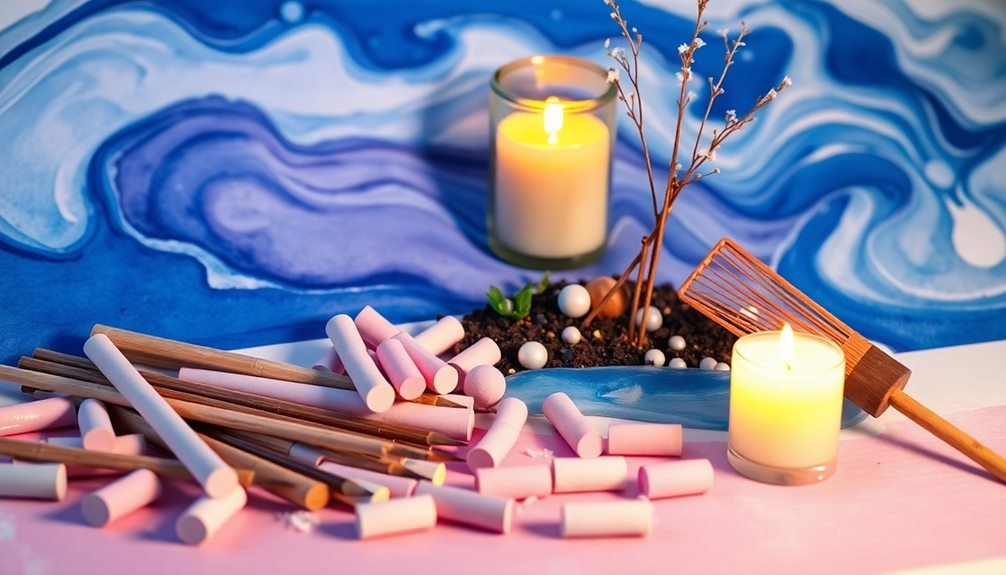
Art therapy harnesses the natural calming effects of creative expression to help manage anxiety symptoms. When you engage in artistic activities, your brain releases dopamine and serotonin, neurotransmitters that reduce stress and improve mood. This process shifts your focus away from anxious thoughts and into the present moment, creating a meditative state similar to mindfulness practices.
You don't need formal training or artistic talent to benefit from art therapy. The goal isn't to create masterpieces but to express yourself freely without judgment. Common art therapy techniques include drawing mandalas, finger painting, sculpting with clay, and creating collages. These activities help you externalize difficult emotions and process them in a safe, controlled way.
Research shows that art therapy can lower cortisol levels, reduce heart rate, and decrease anxiety symptoms in both adults and children. It's particularly effective when combined with traditional therapy methods.
Whether you're dealing with generalized anxiety, social anxiety, or panic attacks, incorporating artistic expression into your self-care routine can provide significant relief. The key is finding art forms that resonate with you personally and make you feel comfortable and relaxed.
Essential Calming Coloring Tools
When beginning your coloring journey for anxiety relief, the right tools can make a significant difference in your experience. Start with high-quality colored pencils that offer smooth layering and blending capabilities, like Prismacolor Premier or Faber-Castell Polychromos. These professional-grade pencils won't scratch or tear your paper, allowing for a more meditative coloring session.
Choose markers with dual tips – fine points for detailed work and brush tips for filling larger areas. Tombow dual brush pens and Copic markers provide excellent control and won't bleed through most coloring book pages. You'll also want to invest in gel pens for adding sparkle and metallic accents to your designs.
For your coloring surface, select books with thick, high-quality paper that can handle multiple mediums without bleeding or buckling. Consider books specifically designed for anxiety relief, featuring mandala patterns or nature scenes.
Don't forget practical accessories like pencil sharpeners, blending stumps, and a comfortable lap desk. These tools will help you maintain focus on the calming aspects of coloring rather than struggling with inadequate supplies that might increase frustration.
Smooth-Flow Markers and Pens
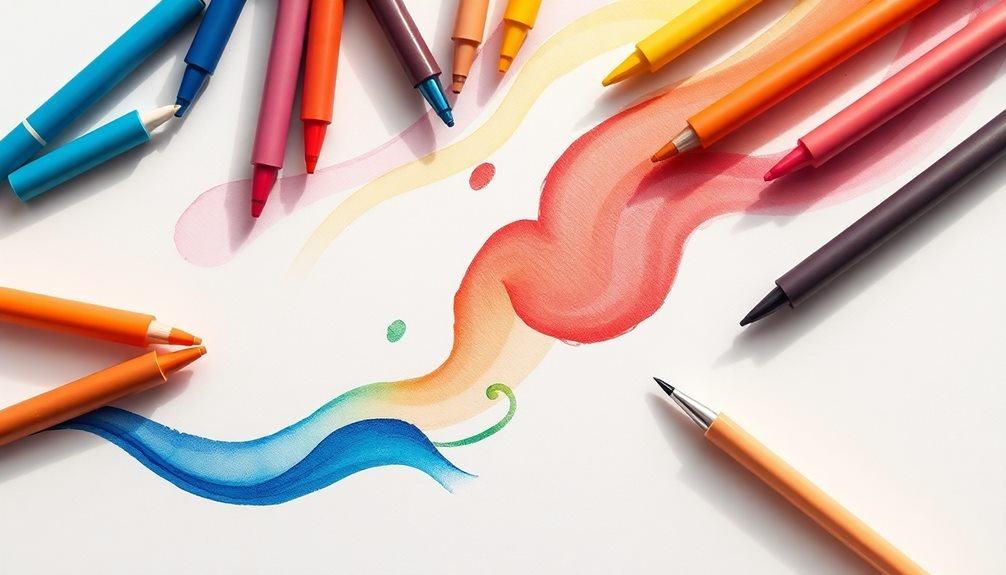
Several smooth-flow markers and pens offer a therapeutic gliding sensation that enhances the anxiety-reducing benefits of coloring. You'll find that these tools create a seamless experience, allowing your mind to focus on the gentle movement across the page rather than your worries.
| Marker Type | Calming Feature |
|---|---|
| Gel Pens | Effortless ink flow |
| Brush Markers | Pressure-sensitive tips |
| Fineliners | Consistent line control |
| Felt Tips | Smooth paper contact |
When selecting your markers and pens, look for options with quick-drying ink to prevent smudging, which can trigger frustration. The best anxiety-reducing markers feature ergonomic grips that won't strain your hands during extended coloring sessions. Choose water-based markers for their non-toxic properties and pleasant, stress-free application.
You'll want to test the markers on your preferred paper type before committing to a full set. Some markers might bleed through thinner papers, while others work perfectly with any surface. Keep your markers stored horizontally to guarantee even ink distribution and maintain that soothing flow that makes them so effective for anxiety relief.
Stress-Relief Drawing Paper Options
The right drawing paper can greatly impact your stress-relief art practice. When you're looking to reduce anxiety through art, you'll want paper that matches your preferred medium and drawing style.
Smooth bristol paper works perfectly for marker art and detailed illustrations, while textured watercolor paper adds a soothing tactile element to your creative process.
Consider keeping different paper types on hand to match your varying emotional needs. A heavyweight mixed media pad lets you experiment freely without worrying about bleed-through, while a spiral-bound sketchbook offers convenient portability for anxiety-busting art sessions anywhere.
- Cold-pressed watercolor paper (140lb) provides a calming texture that's especially soothing when using wet media or colored pencils.
- Smooth bristol board (100lb) offers a clean, precise surface that's ideal for controlled, mindful line work.
- Mixed media paper (98lb) allows for spontaneous creativity with various materials without buckling.
- Toned paper gives you the ability to work with both light and dark highlights, adding dimension while reducing pressure to fill the entire page.
Mindful Watercolor Supplies
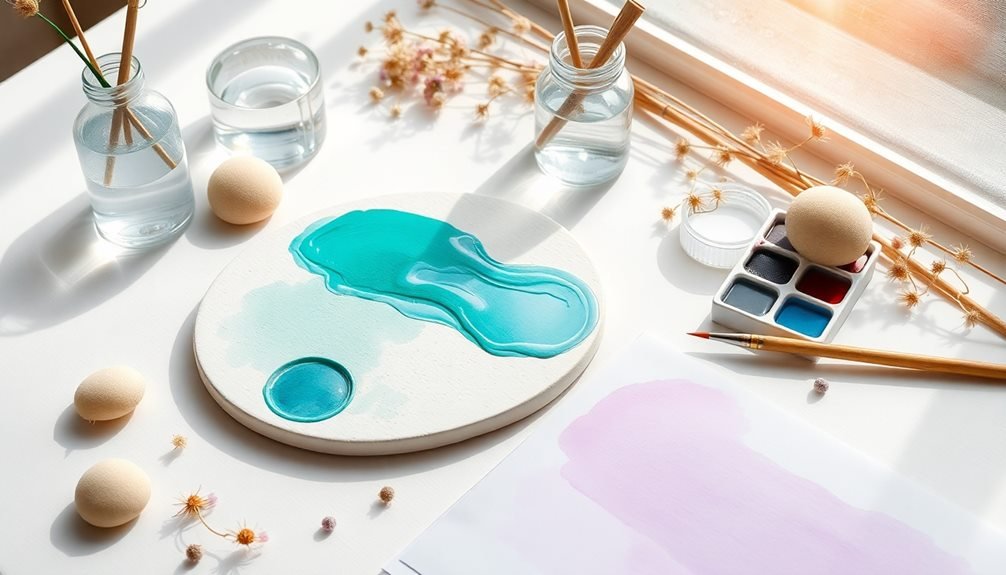
Starting your mindful watercolor journey doesn't require a huge investment – you'll need only a basic starter kit with student-grade paints, a few synthetic brushes, and a mixing palette.
You'll want to pair your supplies with the right paper, focusing on cold-pressed sheets that are at least 140lb weight to prevent buckling and allow proper paint absorption.
To keep your materials in top condition, invest in brush soap, a cleaning mat, and proper storage containers that'll protect your brushes' delicate bristles.
Basic Watercolor Starter Kit
Mindful watercolor painting begins with gathering a few essential supplies that won't overwhelm you as a beginner.
You'll want to start with student-grade materials that offer good quality without breaking the bank. Focus on acquiring watercolor paper (140lb/300gsm), a set of basic watercolor paints (8-12 colors), two or three synthetic brushes in different sizes, and a palette for mixing colors.
For the most relaxing experience, choose supplies that feel comfortable and manageable. You don't need the most expensive materials to create beautiful, stress-relieving art.
Your starter kit should include:
- A cold-pressed watercolor pad (9"x12") that won't buckle when wet and allows paint to flow smoothly
- A set of tubes or pan watercolors featuring primary colors plus green, brown, and black
- Round brushes in sizes 2, 6, and 10 for different techniques and details
- A white plastic or ceramic palette with wells for mixing colors and a large mixing area
Keep your supplies organized in a dedicated space where you can easily access them whenever you need a moment of creative calm.
Premium Paper Selection Guide
Selecting premium watercolor paper can dramatically influence your mindful painting experience. For anxiety-reducing artwork, you'll want to focus on papers that can withstand multiple washes and provide a soothing painting experience.
Start with 140lb (300gsm) cold-pressed paper, which offers a slightly textured surface that's forgiving for beginners. Arches and Winsor & Newton are reliable brands that won't pill or deteriorate as you layer colors.
If you're seeking a smoother experience, hot-pressed paper provides a sleek surface that's ideal for detailed work and controlled brush strokes.
For maximum stress relief, consider 100% cotton papers rather than wood pulp alternatives. Cotton papers absorb water more evenly and won't buckle as much, reducing frustration during your painting sessions. You'll find these available in blocks (glued on all sides) or individual sheets.
Size-wise, start with 9×12 inch sheets for practice. They're large enough to express yourself freely but won't overwhelm you with too much space to fill.
For ultimate convenience, pre-stretched papers or blocks eliminate the need for taping and stretching, letting you focus entirely on the calming aspects of painting.
Essential Brush Care Tools
Proper brush care forms the foundation of a calming watercolor practice, and having the right maintenance tools will help preserve your brushes while reducing anxiety about damaging them.
You'll need a gentle brush soap, a textured cleaning mat, a brush holder, and reshaping liquid to maintain your tools effectively.
When you're done painting, start with the brush soap designed specifically for natural and synthetic bristles. The pH-balanced formula will remove pigment residue without damaging the delicate fibers. A silicone cleaning mat with varied textures helps work the soap through the bristles without excessive force or stress on the brush.
- Keep your brushes upright in a ventilated holder to maintain their shape and prevent water damage to the ferrule.
- Use brush reshaping liquid on natural hair brushes monthly to restore their original spring and point.
- Store brushes away from direct sunlight to prevent brittleness and degradation.
- Clean brushes immediately after use to prevent paint from drying and hardening in the bristles.
With these essential care tools, you'll develop a mindful cleaning routine that extends the life of your brushes and enhances your artistic practice.
Therapeutic Clay and Sculpting Materials
Working with clay can be one of the most grounding anxiety-relief practices you'll experience, whether you choose air-dry clay, polymer clay, or traditional earthen clay.
You'll want to start with a clay type that matches your comfort level – air-dry clay is perfect for beginners, while polymer clay offers vibrant color options and permanent results after baking.
Essential sculpting tools, including wire cutters, wooden modeling tools, and rubber-tipped shapers, will help you create detailed pieces while maintaining a mindful focus on your craft.
Clay Types For Mindfulness
Three main types of therapeutic clay offer distinct tactile experiences for mindfulness practice: polymer clay, air-dry clay, and earthen clay. Each type provides unique sensory feedback and working properties that can help ground you during anxiety-filled moments.
Polymer clay stays pliable until baked, allowing you to work with it repeatedly without drying out. Air-dry clay hardens naturally over time, creating a satisfying progression from soft to firm as you shape your piece. Earthen clay connects you directly to nature, offering a primal tactile experience with its cool, wet texture.
- Working with cold clay activates your parasympathetic nervous system, naturally lowering stress levels
- Repetitive kneading motions help release physical tension while focusing your thoughts
- The malleability of clay provides immediate feedback, keeping you present in the moment
- Creating three-dimensional forms engages spatial reasoning, redirecting anxious thoughts
Choose polymer clay when you want extended working time and permanent results. Opt for air-dry clay when you prefer natural hardening without heat. Select earthen clay when you're seeking the most authentic, grounding experience.
Each type supports mindfulness practice while accommodating different preferences and project needs.
Essential Sculpting Tool Sets
A basic sculpting tool set transforms therapeutic clay work from simple manipulation into a versatile anxiety-management practice. When you're working with clay to reduce stress, having the right tools helps you achieve better results and express yourself more effectively.
Start with a set that includes wire cutting tools, wooden modeling tools, and ribbon tools. You'll need wire tools to slice clay cleanly and separate pieces, while wooden tools help you smooth surfaces and create texture patterns. Ribbon tools are perfect for carving details and removing excess material without leaving marks.
Don't forget loop tools and needle tools – they're essential for adding fine details and creating depth in your clay pieces. A metal scraper and rubber-tipped shaping tools will help you blend seams and create smooth changes between forms.
Consider adding texture mats and stamps to your collection; they're excellent for adding interesting patterns when you need a meditative, repetitive activity.
Store your tools in a roll-up canvas case or dedicated toolbox to keep them organized and protected. Having your tools readily accessible encourages regular practice and helps maintain a calming creative routine.
Mess-Free Art Tools
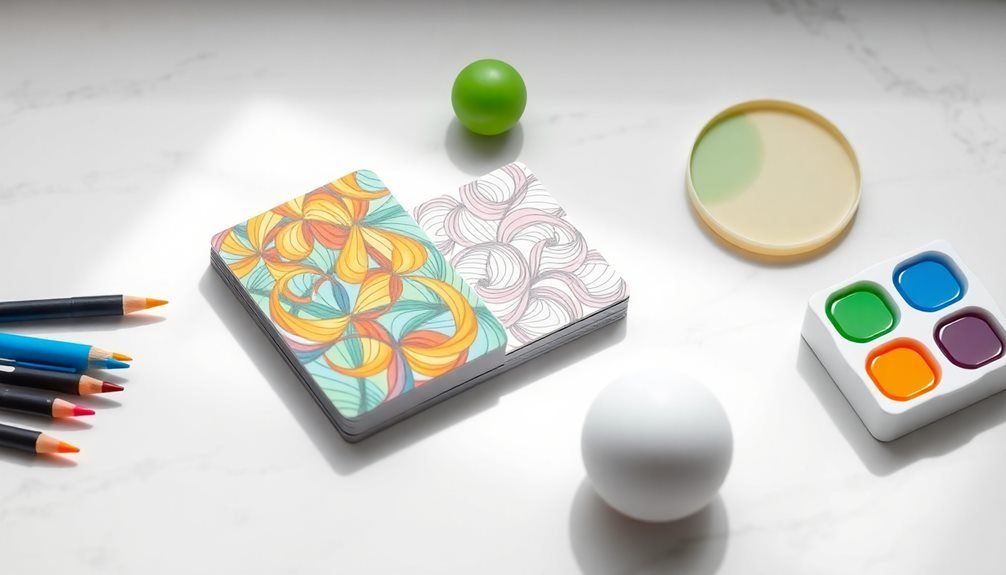
Mess-free art supplies offer a perfect solution for managing anxiety without worrying about cleanup. When you're feeling stressed, the last thing you want is to create additional tension about staining your clothes or furniture.
That's why tools like no-spill paint pods, self-contained coloring sets, and mess-free markers have become increasingly popular among anxiety-conscious artists. Clean art tools allow you to focus entirely on the creative process rather than potential accidents.
You'll find options like water brush pens that contain their own water supply, gel crayons that don't leave residue, and colored pencils with protective coating that prevents smudging. These innovations make it possible to create art anywhere, from your bed to your office desk.
- Water-activated brush pens eliminate the need for separate water containers and minimize spills
- Retractable gel markers with sealed tips prevent ink leakage in bags or pockets
- No-mess glitter pens contain sparkles in a clear solution that dries completely
- Mess-free magic coloring books use special markers that only work on designated pages
Choose tools that match your comfort level with cleanup, allowing your creativity to flow freely without added stress about potential messes.
Portable Sketching Supplies
Portable sketching supplies provide essential relief for those who need creative outlets on the go. You'll find that compact art tools can fit easily in your bag or pocket, ready whenever anxiety strikes. Whether you're traveling, waiting for an appointment, or taking a lunch break, these supplies let you channel nervous energy into creative expression.
| Item | Features | Anxiety-Busting Benefit |
|---|---|---|
| Pocket Sketchbook | 4×6 size, hardcover | Provides contained space for expression |
| Mechanical Pencil | No sharpening needed | Offers reliable, consistent lines |
| Kneaded Eraser | Clean, moldable | Calming to manipulate while thinking |
| Brush Pen | Self-contained ink | Enables fluid, meditative strokes |
| Mini Colored Pencils | 12-color travel set | Allows soothing color therapy |
Choose supplies that won't leak, break, or create mess in your bag. A minimal kit with these five items gives you enough variety without feeling overwhelming. When selecting your portable sketching supplies, prioritize items that feel comfortable in your hands and match your preferred art style. You'll find that having these tools readily available can transform anxious moments into creative opportunities.
Anxiety-Friendly Paint Selection
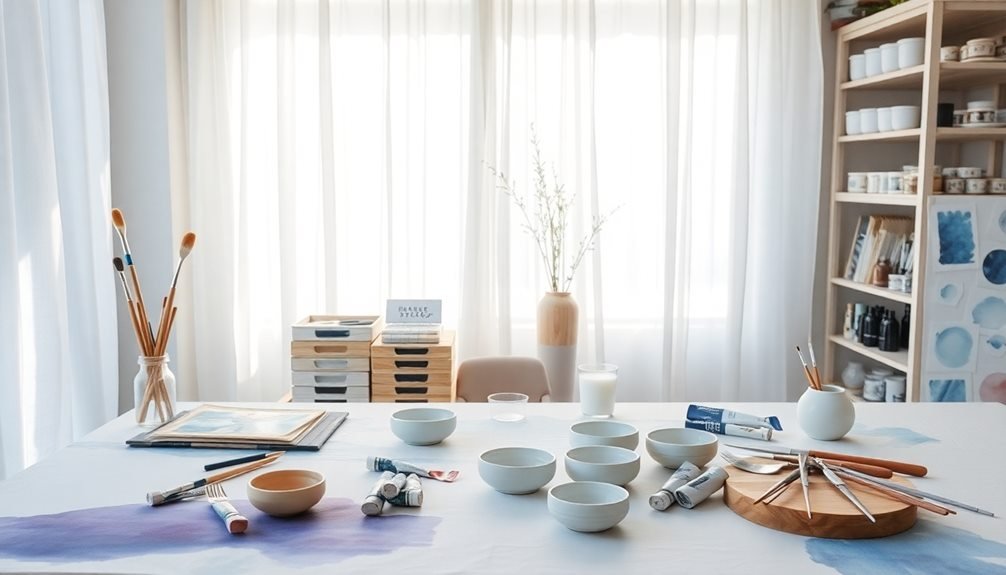
When selecting paints for anxiety relief, choosing the right type can make a significant difference in your creative experience. Watercolors and acrylics tend to be the most anxiety-friendly options, as they're forgiving and easy to control.
Watercolors flow naturally and encourage a letting-go mindset, while acrylics dry quickly and allow for easy coverage of mistakes.
You'll want to start with a limited palette of 5-6 colors to avoid feeling overwhelmed. Look for non-toxic, low-odor paints that won't trigger sensory sensitivities or health concerns. Student-grade paints work well for beginners, offering good quality without the pressure of using expensive materials.
- Choose water-based paints over oil paints, as they're easier to clean up and require fewer harsh chemicals.
- Select paints with a creamy consistency that flow smoothly to reduce frustration during application.
- Opt for matte finishes rather than glossy ones to create a calming visual effect.
- Consider paint markers or brush pens if traditional brushes feel too unpredictable.
Remember to store your paints in clear containers where you can easily see colors, reducing decision fatigue when you're ready to create.
Grounding Art Storage Solutions
Your art supplies deserve a calming home that supports your creative flow and reduces anxiety triggers.
You'll find peace of mind with portable supply roll cases that keep brushes and tools neatly bundled, wall-mounted organizational systems that transform your workspace into a visually soothing environment, and clear stackable storage boxes that let you instantly locate materials.
These storage solutions act as grounding elements in your creative space, keeping everything visible and accessible while eliminating the stress of searching for supplies.
Portable Supply Roll Cases
Organizing art supplies in roll-up cases provides an instantly calming ritual for anxiety management. When you're feeling overwhelmed, having your materials neatly arranged in designated pockets can help restore a sense of control.
Roll cases keep your art supplies secure while offering easy visibility and access, making them perfect for both home use and on-the-go creativity sessions.
Choose a roll case with multiple compartments and elastic straps to keep your anxiety-relief tools organized. You'll want separate sections for colored pencils, markers, brushes, and other materials. The act of rolling and unrolling your supplies can become a meditative practice, helping you shift into a creative mindset.
- Select canvas or waxed cotton cases for durability and water resistance
- Look for cases with clear pockets to quickly identify supplies
- Choose adjustable straps and ties for customizable tension
- Opt for cases with built-in stands or display capabilities
When selecting a roll case, consider the size of your collection and how you'll use it. A compact case works well for everyday carry, while larger rolls accommodate more extensive supplies for longer creative sessions.
Wall-Mounted Tool Organization
Wall-mounted storage solutions transform any art space into a grounding sanctuary for anxiety management. You'll find that vertical organization helps maintain a clear mind by keeping your tools visible yet orderly. Install pegboards, magnetic strips, and wall-mounted shelves to create an anxiety-reducing workspace that lets you focus on your art rather than searching for supplies.
Consider these effective wall-mounting options for different art supplies:
| Storage Type | Best For |
|---|---|
| Pegboard | Brushes, scissors, rulers |
| Magnetic Strip | Metal tools, clips, blades |
| Wire Baskets | Papers, sketchbooks, pads |
| Clear Acrylic | Markers, pens, pencils |
| Floating Shelves | Paint bottles, sprays, jars |
You'll want to arrange your tools by frequency of use, keeping daily items at eye level. Label each storage space clearly to maintain organization and reduce anxiety about misplacing items. Add small LED strip lights above your wall storage to illuminate your supplies and create a calming ambiance that promotes creativity and emotional well-being.
Clear Stackable Storage Boxes
Transparency brings peace of mind when storing art supplies, making clear stackable storage boxes an essential anxiety-reducing solution.
You'll find that organizing your materials in see-through containers helps prevent the stress of searching through opaque bins. These modular boxes let you customize your storage setup while maintaining visual order, which can considerably reduce art supply-related anxiety.
Choose stackable containers with secure latches to keep your supplies protected and dust-free. The clear walls allow you to quickly spot what you need, eliminating the frustration of rummaging through multiple containers.
When selecting your storage boxes, consider different sizes to accommodate various art materials, from tiny beads to larger sketchbooks.
- Opt for containers with removable dividers to create customized compartments for different media types
- Select boxes with reinforced corners to prevent cracking when stacking
- Look for moisture-resistant seals to protect moisture-sensitive supplies like pastels and papers
- Choose containers with comfortable handles for easy transport between work areas
Frequently Asked Questions
Can Art Therapy Help With Panic Attacks During Social Situations?
Yes, art therapy can help you manage panic attacks in social settings. You'll learn calming visualization techniques, grounding exercises through creative expression, and mindful drawing methods that you can discreetly use when feeling overwhelmed.
What Age Is Too Late to Start Using Art for Anxiety Relief?
You're never too old to start using art for anxiety relief. Whether you're 8 or 80, your brain can benefit from creative expression. It's a natural stress-reliever that'll work at any stage of life.
How Long Should Each Art Therapy Session Last for Maximum Benefit?
You'll benefit most from 30-60 minute art therapy sessions, but don't force it. Listen to your body – if you're feeling relaxed after 15 minutes or energized after 90, that's perfectly fine too.
Will Insurance Cover Art Supplies Prescribed for Anxiety Treatment?
You'll need to check with your insurance provider, as coverage varies widely. Some plans may cover art supplies if they're prescribed by a licensed therapist as part of your documented mental health treatment plan.
Can I Combine Anxiety Medication With Art Therapy Safely?
You can safely combine art therapy with anxiety medication, but you'll want to discuss this with your doctor first. They'll help guarantee the activities don't interfere with your treatment and may adjust your plan accordingly.
In Summary
You'll find that building your own anxiety-busting art supply collection is a journey worth taking. Start small with basic tools that feel right for you, gradually adding items that enhance your creative relaxation practice. Remember, there's no "perfect" set – it's about what helps you unwind. Keep your supplies organized and accessible, making it easier to reach for them whenever stress strikes.

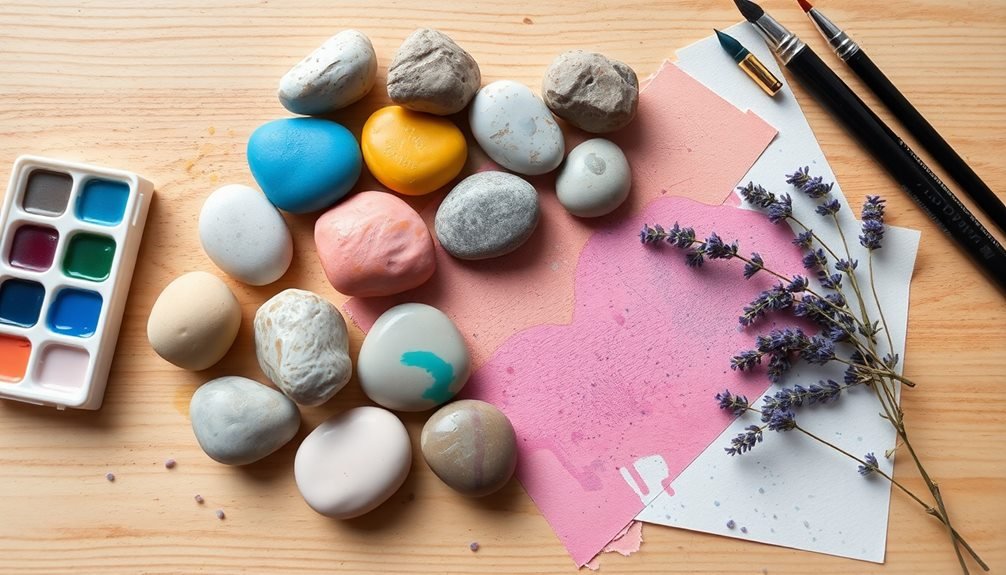
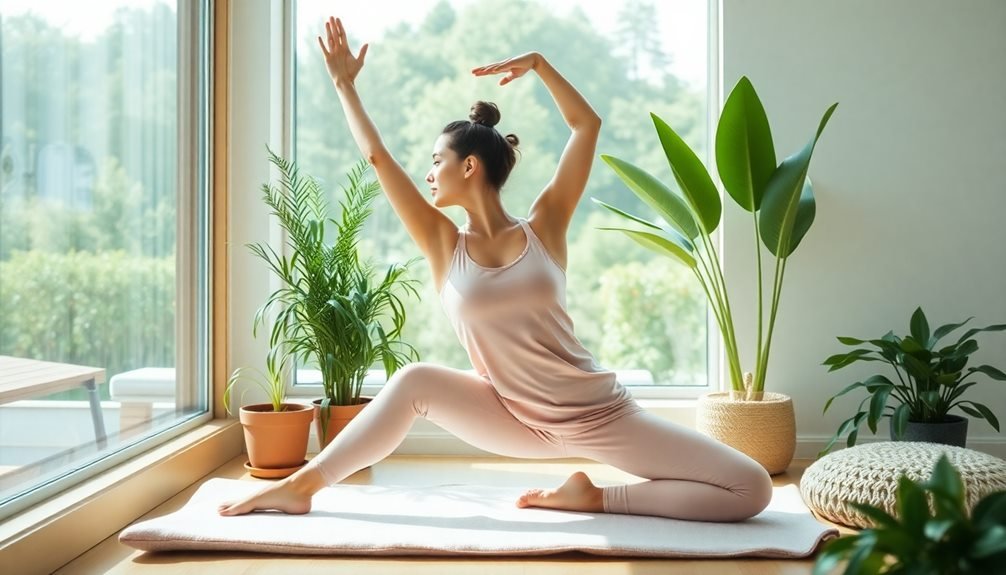
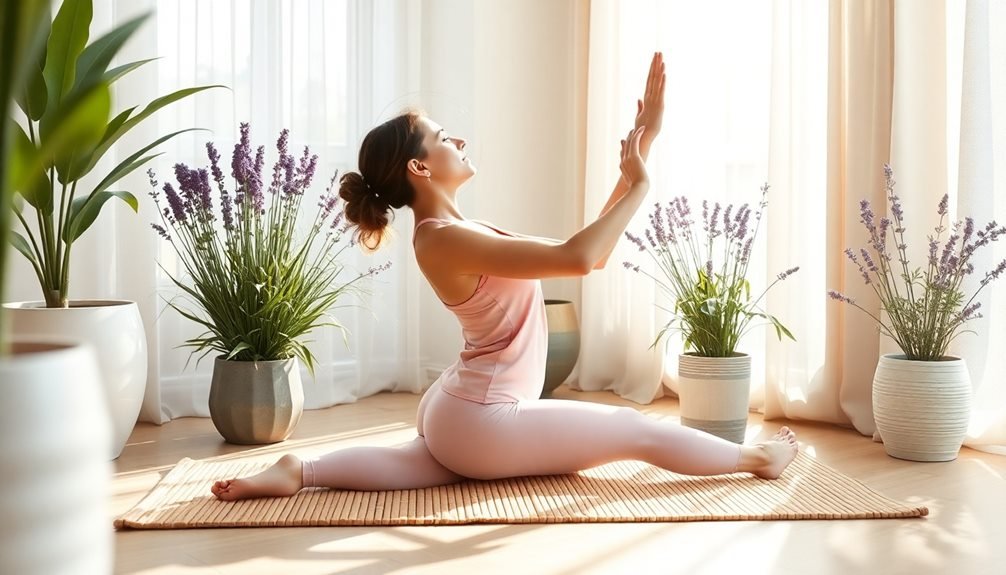
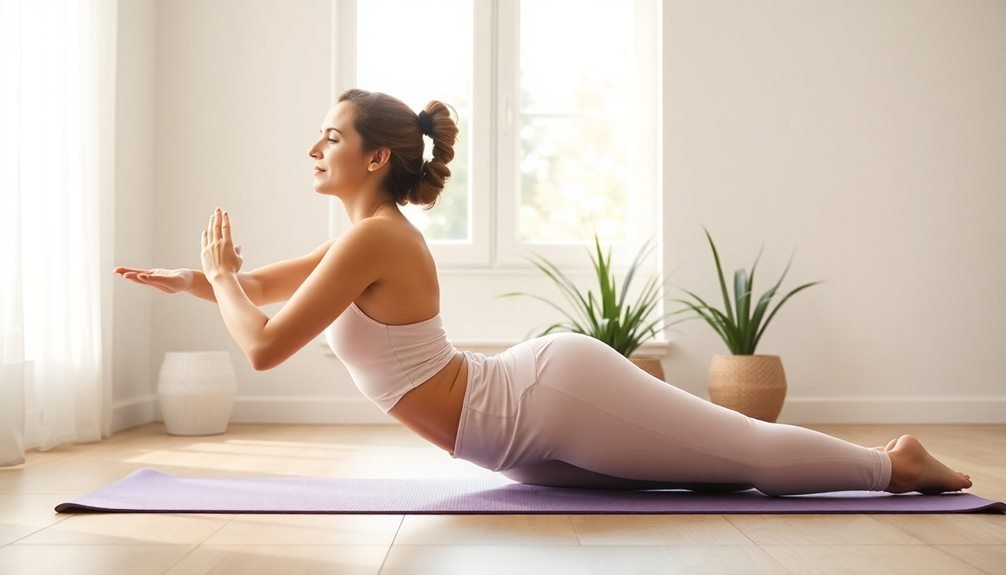
Leave a Reply